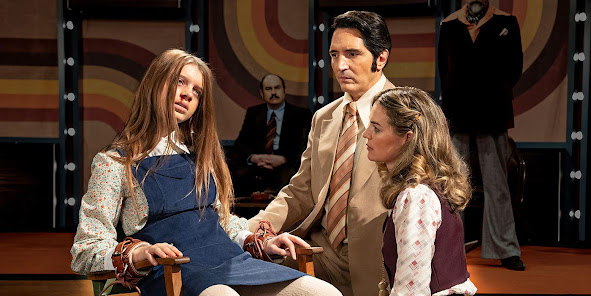In some ways, Godzilla x Kong: The New Empire fares best when comparing it to other movies. It’s certainly a good deal better than the 2019 MonsterVerse installment Godzilla: King of the Monsters, for instance. That Michael Dougherty directorial effort had human characters who were outright irritating, the flesh-and-blood humans of The New Empire are more bland than anything else. Meanwhile, The New Empire also stands tall compared to fellow 2024 blockbusters Argylle and Madame Web. Those titles failed to deliver the basic indulgences would want from spy and superhero movies, respectively. Director Adam Wingard at least gives audiences plenty of Kaiju shenanigans for the price of one ticket.
Of
course, this cuts both ways. For instance, Godzilla x Kong: The New Empire
pales in comparison to the 2014 Godzilla title. That attempt to create a
modern ominous Godzilla feature is now a distant speck in the distance of this
franchise’s rearview mirror. More pressingly Godzilla Minus One just
dropped four months ago. That modern classic (among its many accomplishments) proved
you can have a Godzilla feature with compelling human characters! Godzilla
x Kong: The New Empire stands tall when compared to some blockbuster
movies. Unfortunately, its gravest flaws become unavoidable when placing it side-by-side superior big-budget fare. Being better than Godzilla: King of the Monsters doesn't turn your monster movie homage into Pacific Rim.
What's the plot of Godzilla x Kong: The New Empire? Simultaneously a whole lot and not much. Kong is lonely in his Hollow Earth domicile. However, he quickly discovers that he's not the only gigantic ape in this territory. Meanwhile, on the surface level of Earth, Godzilla is protecting humanity from big beasts. Screenwriters Terry Rossio, Simon Barrett, and Jeremy Slater struggle to come up with compelling material for Godzilla, so this character spends much of The New Empire just going on sidequests to prepare for the finale. There are also humans! Humans are also here. MONARCH scientist Dr. Ilene Andrews (Rebecca Hall) is struggling to connect with her teenage daughter Jia (Kaylee Hottle), who previously lived with Kong in Hollow Earth. These two, along with master veterinarian Trapper (Dan Stevens) and conspiracy theorist Berni Hayes (Brian Tyree Henry), head to the middle of the planet to help Kong. There, they discover a new threat in the form of knife-wielding red ape Skar King that could put all of creation into jeopardy.
Ten years into the MonsterVerse, we're still being forced to hang out with human characters that nobody has much of a vested-interest in. If you can't come up with the compelling intimate drama of Godzilla Minus One, ditch the human beings! It's especially funny here since the humans don't have any real purpose beyond just being a mouthpiece for kaiju lore. There are no attempts at character arcs, blossoming romances, or any other interpersonal material for these figures. The lack of effort is palpable. This flaw is especially odd on two levels. For one thing, Jia has a potentially interesting story related to her struggles to feel like she belongs on the surface world. She's also the only one of the primary humans to have a direct connection with our beastly protaganists (she used to be best pals with Kong).
However, the movie keeps her at a distance and frames her story through the eyes of Andrews. What a waste of potential. Also odd is that the primary four humans are totally disconnected physically from Godzilla and Kong for much of the runtime. That means we have to keep cutting back-and-forth from Kong's odyssey across Hollow Earth to humans navigating an ancient temple. It's a peculiar story structure, especially since it keeps distracting from the best parts of the proceedings. Quiet dialogue-free sequences concerning Kong and new character Mini-Kong (an adolescent orange ape) are very enjoyable. It's fun to see how they communicate the interior thoughts of these primates through just body language. Alas, these scenes can't last too long.
By the end, the humans take a backseat to a lengthy burst of monster mayhem that is quite fun to watch. Scar King's fighting style being molded after what can be best described as "pirate brawler" especially makes him a fun figure to watch tangle with Kong and Godzilla (who opt for more primal bursts of aggressive physicality). With this lengthy set piece, audiences will certainly get what they came for with Godzilla x Kong: The New Empire. Given how totally incompetent these American blockbusters can be, that counts for something. Then again, hitting the bare minimum isn't a massive triumph. Godzilla x Kong: The New Empire provides fleeting bursts of fun, but being superior to Madame Web doesn't make it a towering accomplishment.
BUT WHAT ABOUT THE SCORE???
Tom Holkenborg A.K.A. Junkie XL provided the score for Godzilla x Kong: The New Empire. Holkenborg exploded in popularity as a film composer after his iconic work on Mad Max: Fury Road. Unfortunately, since then, his work as a composer has been thoroughly generic. Alas, Godzilla x Kong: The New Empire does not reverse this trend. I initially liked that he was aiming for an 80s-synth noise with his compositions, that's not quite a sound we've heard before in the MonsterVerse. He and fellow composer Antonio Di Iorio, though, fail to lend dimensions to that sound. There aren't crests and waves to his compositions, no modulations that suggest variety in the tone or atmosphere of The New Empire. It's just the same homophonic blurbs repeated. The electronic influences also vanish once the final fight starts, which means Holkenborg and Di Iorio's compositions just start sounding like a generic Hans Zimmer blockbuster movie score. Compare these tracks to Bobby Krlic's electronic score for Blue Beetle (which did have exciting variations) and it's just no contest. Here's to hoping Holkenborg strikes back as a composer with Furiosa in May.











